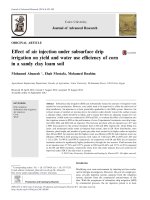Effect of soil texture on drying pattern of soil moisture after saturation
Bạn đang xem bản rút gọn của tài liệu. Xem và tải ngay bản đầy đủ của tài liệu tại đây (262.67 KB, 8 trang )
Int.J.Curr.Microbiol.App.Sci (2019) 8(3): 697-704
International Journal of Current Microbiology and Applied Sciences
ISSN: 2319-7706 Volume 8 Number 03 (2019)
Journal homepage:
Original Research Article
/>
Effect of Soil Texture on Drying Pattern of Soil Moisture after Saturation
Pragyan Paramita Rout* and K. Arulmozhiselvan
Department of Soil Science and Agricultural Chemistry, Tamil Nadu Agricultural University
(TNAU), Coimbatore-641003, Tamil Nadu, India
*Corresponding author
ABSTRACT
Keywords
Soil texture,
Gravimetric water
content, Moisture
depletion rate,
Drying pattern
Article Info
Accepted:
07 February 2019
Available Online:
10 March 2019
The variability in water retention in soil is primarily attributable to soil texture which is
mainly responsible for pore geometry and discontinuity, when compared to soil
mineralogy. Under field conditions soil moisture variability is a major constraint for proper
soil water management. In the present study, a pot experiment was conducted with an
objective of assessing the effect of soil texture on moisture content and its depletion rate.
For this purpose, the soils of seven variable textures were pre saturated and allowed to
follow a drying period up to 15 days. The absolute moisture content of the soil was
measured by direct gravimetric method. Besides, per cent moisture saturation and moisture
depletion rate were also computed. The results showed that sandy texture (sandy, loamy
sand) had low gravimetric water content (GWC) followed by a moderate GWC in loamy
texture (sandy clay loam, clay loam, sandy loam). The highest GWC was recorded in clay
texture (clay and sandy clay). The sandy texture exhibited a sharp drop in GWC up to a
period of 7 days and thereafter attained a steady state of depletion. The results clearly
indicated that fine clayey texture exhibited initially low depletion rate of 2.28 per cent
GWC loss/day and could retain moisture for long period, wherein coarse sandy texture lost
moisture at a faster rate with an initial depletion rate of 6.70 per cent GWC loss/day. The
study concluded that there was a significant variability in moisture content and moisture
retention pattern among the soils of variable texture. Hence, such in situ variability in
drying pattern must be assessed prior to irrigation for efficient water management.
and surface erosion (Mittelbach et al., 2012),
hence has significant influence on engineering
(Terzaghi, 1943), agronomic (Haines, 1923;
Baver, 1956), geological (Fang and Daniels,
2006), ecological and hydrological (Hillel,
1980) behavior of soil. Mechanical properties
of soil viz., consistency, compatibility,
cracking, swelling, shrinkage and density are
also dependent on soil moisture content
(Jones, 1990). Furthermore, it has a major
role in plant growth, sustenance of natural
Introduction
Soil is highly heterogeneous, with soil
moisture being one of its most important
spatiotemporal variables (Parvin and Degre,
2016). Soil moisture (water) is an inevitable
part of three phase system of soil which
comprises of solids (minerals), air and water
(Das, 2004; Craig, 2005). The moisture
dynamics of soil affect water fluxes
throughout the soil profile, evapotranspiration
697
Int.J.Curr.Microbiol.App.Sci (2019) 8(3): 697-704
ecosystems and biodiversity in soil (Howell,
2001).
Collection of soils of variable texture and
preliminary analysis
The
moisture
retention
relationships,
characterized by soil water content and
potential are not unique and are affected by
several environmental and soil factors
(Teuling and Troch, 2005).The variability in
soil texture which is responsible for irregular
pore geometry and discontinuity, are the
primary soil properties that influences soil
water retention (Fares et al., 2011). In
agricultural fields, the particle size
distribution in soil is non-uniform. In different
locations, the soils have variable texture and
hence have different pore volume and clay
content, accordingly exhibit variations in
moisture
content
under
same
environment(Dobriyal et al., 2012). Hence,
the accurate quantification and detailed
investigation on moisture content as well as
its retention properties in various soil textures
has practical implications in hydrological
studies, irrigation scheduling, validation of
soil water models and other environmental
assessments (SushaLekshmi et al., 2014).
The composite surface (0-15 cm) soil samples
were collected from different locations of
Tamil Nadu having majorly occurring seven
texture viz., sandy, sandy loam, sandy clay
loam, loamy sand, clay loam, sandy clay and
clay. The textural analysis was carried out
using International pipette method (Piper,
1966). Other physical properties viz., bulk
density (BD), porosity and water holding
capacity (WHC) were estimated by using
Keen Rackzowski box (Hillgard apparatus)
method. The moisture at field capacity (FC)
and permanent wilting point (PWP) of soil
moisture tension in these soils was estimated
using pressure plate apparatus by following
North Carolina State University Substrate
Laboratory (NCSL) method as described by
Milks et al., (1989).
Methodology of experimentation
Experimental design and treatment details
For the experimental set up, soils of seven
variable texture were collected, processed to
pass through 2 mm sieve, and then filled in
plastic pots of 10 kg capacity in three
replications. In each pot 8 kg of dry soil was
filled. While starting the experiment, initially,
on previous day evening, distilled water was
added to each pot through the sides in order to
saturate the soil and permit air to escape from
the center. After complete saturation with
ponding of water on surface the pot was left
aside.
A pot experiment was conducted in soils of
seven variable texture with three replications.
In this experiment, the soil samples were presaturated with water and allowed to dry up to
a period of 15 days. The absolute moisture
content of the soil was measured by direct
gravimetric method thrice a day from
saturation to drying. The experimental design
and treatment details are presented in Table 1.
Then the soil was allowed to drain the excess
water through the hole provided at the bottom
of the pot. Thereafter, the pot was left overnight to uniformly moisten the soil
throughout. The pre-saturated soil was
allowed to dry and then soil moisture was
recorded thrice a day. For this purpose, the
entire pot was weighed on a digital weighing
balance. The weight of the pot along with soil
With this background, a pot experiment was
conducted with an aim of assessing the effect
of soil texture on moisture content, moisture
depletion during drying period after
saturation.
Materials and Methods
698
Int.J.Curr.Microbiol.App.Sci (2019) 8(3): 697-704
was measured. The gravimetric water content
was measured using the following formula
Gravimetric
water
content (%)
Moisture depletion rate
The moisture depletion rate on per day basis
(% GWC loss/day) over a period of 15 days is
calculated as follows
Weight of pot with
moist soil (g) Weight of pot with X
= dry soil (g)
100
Weight of dry soil
filled in pot (g)
Moisture
GWC (%) at a particular day
depletion
– GWC (%) at next
rate
observation
(%
=
GWC
No. of days between
loss
observations
/day)
For further interpretation, the soil moisture
was also expressed in terms of volumetric
moisture content using the following formula
Statistical
Gravimetric water content (g/g)
X Bulkanalysis
Density of soil
Volumetric
3
water content = (Mg/m )
X 100
The data on gravimetric water content
3
(%)
Density of water (Mg/m )
recorded on day basis in soils of variable
texture during drying period were subjected to
Estimation of moisture depletion rate in
analysis of variance (ANOVA) as suggested
soils of variable texture during drying
by Panse and Sukhatme (1985). The standard
period
error of difference (SEd) and CD (P = 0.05)
values were computed and used to test the
The gravimetric water content (% GWC) in
significance of soil texture on gravimetric
soils of seven variable textures was recorded
water content. For statistical analysis of data,
for period of 15 days during drying period. In
Microsoft Excel (Microsoft Corporation,
continuation, the moisture depletion rate (%
USA) package was used.
GWC loss/day) and per cent moisture
saturation (%) were also calculated on day
Results and Discussion
basis using following formula
Physical properties of soils
Per cent moisture saturation
The results on physical properties of soils
(Table 2) showed that the soil of variable
texture varied widely in their properties. The
particle size analysis showed that sand
fraction ranged from 17.6 (S7) to 91.2 per cent
(S1), silt fraction ranged from 4.3 (S1) to 26.1
per cent (S5) and clay fraction ranged from
4.5 (S1) to 62.0 per cent (S7). Among the
samples, S1 and S2 were categorized as sandy;
S3, S4 and S5 were grouped as loamy; and S6
and S7 were grouped as clayey in behavior.
The gravimetric water content at day 1 was
taken as saturation and expressed as 100 per
cent moisture. Thereafter, the percentage of
moisture was calculated as per cent saturation
on per day basis over a period of 15 days as
follows
Moisture
saturation
(%)
Gravimetric water
content (%) at a
particular day
X
=
Gravimetric water 100
content
(%)
at
saturation
The bulk density of soil samples ranged from
1.24Mg/m3 in clay texture to 1.69 Mg/m3 in
699
Int.J.Curr.Microbiol.App.Sci (2019) 8(3): 697-704
sandy texture. The clay texture had the
highest porosity of 53.3 per cent and sandy
texture recorded the lowest porosity of 36.4
per cent. The field capacity (FC) and
permanent wilting point (PWP) varied among
the samples. The sandy texture recorded the
lowest FC and PWP of 13.9and 8.1 per cent
VWC, wherein clay texture recorded the
highest FC and PWP of 47.8and 34.6 per cent
VWC respectively. The available water
capacity of soil samples ranged from 5.8 to
18.9 per cent VWC.
day 15 with overall mean of 3.00 per cent
GWC. The textural mean ranged from 5.74
per cent GWC in sandy texture to 22.56 per
cent GWC in clayey texture. The results
clearly indicated that clayey texture could
retain moisture for long period wherein sandy
texture drained water in a faster rate. This
might be attributed to the fact that clayey
texture with fine soil particles have significant
fraction of water that might be held tightly to
clay matrix by strong matric forces which is
responsible for high water retention capacity
(Easton, 2016).
Depletion of soil moisture in soils of
variable texture during drying period
The change in GWC followed almost a linear
decreasing trend as drying period proceeded
in all texture. However, rate of decrease was
steady in fine clayey texture (clay, sandy
clay), loamy texture (sandy clay loam, clay
loam, sandy loam). In coarse sandy texture
(sandy and loamy sand), there was a sudden
drop in water content during the initial period
of 7 days and thereafter it followed a steady
depletion trend. Such phenomenon might
have occurred due to the initial draining of
water from macro pores at a faster rate in
coarse textured soil and thereafter the water in
micro pore get emptied comparatively at a
slower rate (Morgan et al., 2001).
The gravimetric water content (% GWC) in
soils of seven variable texture was recorded
for period of 15 days during drying period.
The soil texture has a profound influence on
GWC. The effect of texture on depletion of
soil moisture was compared statistically.
Gravimetric water content
The results on effect of soil texture on GWC
over a period of 15 days (Fig. 1) showed that
the lowest GWC of 19.47 per cent was
recorded in sandy texture and the highest
GWC of 36.43 per cent was observed in
clayey texture at saturation on day 1 with an
overall mean of 30.12 per cent GWC. This
might be due to the high micro pores in
clayey texture that could hold more water
even after draining of free gravitational water
after saturation (Qi et al., 2018). Similar
results were also reported by Payero et al.,
(2017).
Among soil texture, sandy and loamy sand
texture had similar effect on gravimetric
water content and were statistically at par
with a mean value of 5.74 and 6.67 per cent
GWC respectively. Other texture viz., sandy
clay loam, sandy loam and clay loam had
similar water content with a mean value of
19.42, 19.28 and 20.23 per cent GWC
respectively.
In sandy and loamy sand texture, 50 per cent
GWC was attained in day 3. However in other
texture, 50 per cent GWC was recorded in day
9 except sandy clay texture which have
recorded 50 per cent GWC in day 8. The
GWC ranged from 0.31 per cent in sandy
texture to 6.77 per cent in clayey texture on
The clay texture recorded higher water
content (22.56% GWC) than other texture
which was statistically significant. Similar
water retention behavior in soils of variable
texture was also reported by Huang and
Bingke (2016).
700
Int.J.Curr.Microbiol.App.Sci (2019) 8(3): 697-704
was achieved in day 2. However in other
texture, 50 per cent moisture saturation was
recorded in day 9 except sandy clay texture
that recorded 50 per cent moisture saturation
in day 8. At day 15, per cent moisture
saturation was lowest in loamy sand texture
(1.45%) and highest in clay texture (18.58%)
with an overall mean of 8.88 per cent. The
textural mean of moisture saturation ranged
from 29.46 to61.92 per cent. Similar results
were also reported by Amooh and Bonsu
(2015) who stated that the sandy loam texture
had more moisture saturation than coarse
textured soil (loamy sand and sand).
Per cent moisture saturation
The results on effect on soil texture on per
cent moisture saturation (Table 3) showed
that the moisture saturation progressively
decreased as drying period progressed. At day
1, all soil texture attained 100 per cent
moisture saturation. On day 2, the lowest
moisture saturation of 65.61 per cent was
recorded in sandy texture and the highest
moisture saturation of 93.75 per cent was
observed in clayey texture with an overall
mean of 85.36 per cent. In sandy and loamy
sand texture, 50 per cent moisture saturation
Table.1 Treatment details of pot experiment in soils of variable texture
Tr. No. Soil types (7 texture) with location
Sandy
: Ervadi, Nagapattinam (10.765° N, 79.842° E)
T1
Loamy sand
: Andipatti,Theni (10.002° N, 77.616° E)
T2
Sandy clay loam : LTFE, TNAU, Coimbatore (11.015° N, 76.932° E)
T3
Sandy loam
: Ayalur, Gobichettipalayam (11.450° N, 77.430° E)
T4
Clay loam
: Eachankudi, Thanjavur (10.787° N, 79.138° E)
T5
Sandy clay
: Ichipalayam, Erode (11.341° N, 77.717° E)
T6
Clay
: Wetland, TNAU, Coimbatore (11.01° N, 76.93° E)
T7
: Three
Replication
: Completely Randomized Design (CRD)
Design
: Saturation to dry (Thrice a day)
Moisture measurement
: 15 days
Duration
Table.2 Physical properties of soils of variable texture
S.
No.
S1
S2
S3
S4
S5
S6
S7
Soils of
variable
Texture
Sand
(%)
Silt
(%)
Clay
(%)
Bulk
Density
(Mg/m3)
Porosity
(%)
Field
Capacity
(% VWC)
Sandy
Loamy sand
Sandy clay
loam
Sandy loam
Clay loam
Sandy clay
Clay
91.2
82.5
65.3
4.3
8.3
13.1
4.5
9.2
21.6
1.69
1.61
1.45
36.4
39.3
45.2
71.4
42.3
57.5
17.6
11.5
26.1
4.5
20.4
17.1
31.6
38.0
62.0
1.53
1.42
1.36
1.24
42.1
44.9
48.7
53.3
VWC: Volumetric Water Content (%)
701
13.9
14.9
33.5
Permanent
Wilting
Point
(% VWC)
8.1
8.4
17.8
Available
Water
Capacity
(%VWC)
5.8
6.5
15.7
32.4
38.8
46.6
47.8
16.4
19.9
32.2
34.6
16.0
18.9
14.4
13.2
Int.J.Curr.Microbiol.App.Sci (2019) 8(3): 697-704
Table.3 Effect of soil texture on Per cent moisture saturation (%) during drying period
Texture
Day 1
S
LS
SCL
SL
CL
SC
C
Mean
100.00
100.00
100.00
100.00
100.00
100.00
100.00
100.00
Day
2
65.61
72.16
92.76
90.50
91.21
91.51
93.75
85.36
Day
3
49.60
52.01
86.26
83.22
85.16
82.35
88.51
75.30
Day
4
42.02
46.98
79.62
79.57
80.23
74.15
82.50
69.30
Day
6
28.77
32.18
72.10
71.95
67.67
64.43
74.45
58.79
Day
7
23.12
25.28
61.59
63.59
62.74
58.22
65.36
51.41
Day
8
17.38
21.34
55.28
55.17
56.62
52.46
58.54
45.25
Day
9
12.73
17.40
48.65
50.54
50.36
45.39
51.87
39.56
Day
10
8.70
13.08
40.85
43.47
45.45
38.73
45.39
33.67
Day
13
2.13
5.82
30.35
29.28
32.15
25.15
35.68
22.94
Day Day Mean
14
15
1.89 1.58 29.46
3.51 1.45 32.60
20.22 11.43 58.26
18.85 9.52 57.97
22.61 12.16 58.86
17.07 7.47 54.74
28.36 18.58 61.92
16.07 8.88
Table.4 Effect of soil texture on Moisture depletion rate (% GWC loss / day) during drying
period
Texture
S
LS
SCL
SL
CL
SC
C
Mean
Day
1
6.70
5.69
2.41
3.16
3.02
2.84
2.28
3.73
Day
2
3.12
4.12
2.17
2.42
2.08
3.07
1.91
2.70
Day
3
1.48
1.03
2.21
1.21
1.69
2.75
2.19
1.79
Day
4
1.29
1.51
1.25
1.27
2.16
1.63
1.47
1.51
Day
6
1.10
1.41
3.51
2.78
1.70
2.08
3.31
2.27
Day
7
1.12
0.80
2.10
2.80
2.10
1.93
2.48
1.91
Day 8
0.91
0.81
2.21
1.54
2.15
2.36
2.43
1.77
Day
9
0.79
0.89
2.60
2.35
1.69
2.23
2.36
1.84
Day
10
0.43
0.49
1.17
1.57
1.52
1.52
1.18
1.13
Day 13
0.05
0.47
3.38
3.47
3.28
2.70
2.67
2.29
Day
14
0.06
0.42
2.93
3.10
3.59
3.22
3.57
2.41
Fig.1 Depletion of gravimetric water content in soils of variable texture during drying period
702
Mean
1.55
1.60
2.36
2.33
2.27
2.39
2.35
Int.J.Curr.Microbiol.App.Sci (2019) 8(3): 697-704
Moisture depletion rate
References
The results on effect of soil texture on
moisture depletion rate (Table 4) showed that
there was a significant variation in moisture
depletion rate among the soil texture. On day
1, the sandy texture recorded the highest
moisture depletion rate of 6.70 per cent GWC
loss/day and clay texture recorded the lowest
moisture depletion rate of 2.28 per cent GWC
loss/day with overall mean of 3.73 per cent
GWC loss/day. The moisture depletion rate
decreased as day proceeded over a period of
15 days in sandy and loamy sand texture. In
other texture, the moisture depletion rate
decreased followed by a subsequent increase
at day 14 and ranged from 0.06 per cent in
sandy texture to 3.59 per cent GWC loss/day
in clay loam texture with over all mean of
2.41 per cent GWC loss/day. The textural
mean of moisture depletion rate ranged from
1.55 to2.36 per cent GWC loss/day.
Amooh, M.K. and M. Bonsu. 2015. Effects of
Soil Texture and Organic Matter on
Evaporative Loss of Soil Moisture.
Journal of Global Agriculture and
Ecology.,3(3): 152-161.
Baver, L.D. 1956. Soil Physics, John Wiley
and Sons, New York.
Craig, R.F. 2005.Craig’s Soil Mechanics, E
and FN Spon, London.
Das, B.M. 2004. Principles of Geotechnical
Engineering, fifth ed., Thomson,
Bangalore, India.
Dobriyal,P., A. Qureshi, R. Badola and S.A.
Hussain. 2012. A review of the
methods available for estimating soil
moisture and its implications for water
resource management. Journal of
Hydrology.,458-459:110–117.
Easton, Z.M., 2016. Soil and Soil Water
Relationships. Virginia Tech, Virginia
State university. Publication BSE194P.
Fang, H.Y. and J.L. Daniels. 2006.
Introductory geotechnical engineering
– an environmental perspective,
Taylor and Francis, New York.
Fares, A., F. Abbas and S. Fares. 2011. Field
Calibrations of Soil Moisture Sensors
in a Forested Watershed. Sensors.,
11(6): 6354-6369.
Haines, W.B. 1923. The volume changes
associated with variation of water
content in soils. Journal of
Agricultural Science., 13: 296-310.
Hillel. D. 1980. Fundamentals of soil physics,
Academic press, New York.
Howell, T.A. 2001.Enhancing water use
efficient in irrigated agriculture.
Journal of Agronomy, 93(2): 281-289.
Huang, X. and G. Bingke. 2016. Review of
soil moisture characteristic curve.
Journal of Agricultural Technology
Services., pp: 33.
Jones, H.G. 1990. Plant water relations and
In conclusion, the present study showed that
the soil texture significantly influenced the
soil water content, moisture saturation and
moisture depletion rate. Among seven soil
texture, fine clayey texture (clay, sandy clay)
recorded high water retention, prolonged
period of moisture saturation as well as slow
moisture depletion rate. The loamy texture
(sandy clay loam, clay loam and sandy loam)
had a moderate moisture saturation as well as
depletion rate. The lowest water retention
behavior was exhibited in coarse sandy
texture (sandy and loamy sand) with a faster
moisture depletion rate. The slope of decrease
in gravimetric water content during drying
period was steady in clayey and loamy
texture, while it was sharp in sandy texture.
Hence, proper assessment of moisture
retention in soils of variable texture would
help in identifying the extent of availability of
soil water to crops and plan for proper
scheduling of irrigation.
703
Int.J.Curr.Microbiol.App.Sci (2019) 8(3): 697-704
implications for irrigation scheduling,
ActaHorticulturae, 278: 67-76.
Milks, R.R., W.C. Fonteno and R.A. Larson.
1989. Hydrology of horticultural
substrates:Predicting
physical
properties of media in containers.
Journal of American Society of
Horticultural Science., 114: 53-56.
Mittelbach, H., I. Lehner and S.I. Seneviratne.
2012. Comparison of four soilmoisture
sensor types under field conditions in
Switzerland. Journal ofHydrology.,
430-431: 39-49.
Morgan, K.T., L.R. Parsons and T.A.
Wheaton. 2001. Comparison of
laboratoryandfield-derived soil water
retention curves for a fine sand soil
using tensiometric, resistance and
capacitance methods. Plant and
Soil.,234: 153-157.
Panse, V.G. and P.V. Sukhatme. 1985.
Statistical Methods for Agricultural
Workers. Publication and information
division. ICAR, New Delhi.
Parvin, N. and A. Degre. 2016. Soil-specific
calibration of capacitance sensors
considering clay content and bulk
density. Soil Research.,54: 111-119.
Payero, J.O., X. Qiao, A. Khalilian, A.
Mirzakhani-Nafchi, R. Davis. 2017.
Evaluating the Effect of Soil Texture
on the Response of Three Types of
Sensors Used to Monitor Soil Water
Status. Journal of Water Resource and
Protection., 9: 566-577.
Piper,
C.S.
1966.Soil
and
plant
analysis.International
Science
publishers Inc., New York.
Qi, Z., S. Jingfang and L. Wenwei. 2018. A
survey about characteristics of soil
water
retention
curve.
2nd
International Workshop on Renewable
Energy and Development (IWRED
2018), IOP Conference Series: Earth
Environmental Science.,153: 062076.
SushaLekshmi, S.U., D.N. Singh and M.S.
Baghini. 2014. A critical review of
soil
moisture
measurement.
Measurement.,54: 92-105.
Terzaghi,
K.
1943.Theoretical
Soil
Mechanics, John Wiley and Sons,
New York.
Teuling, A.J. and P.A. Troch. 2005. Improved
understanding
of
soil
moisturevariability
dynamics.
Geophysical Research Letters.,32:
L05404.
How to cite this article:
PragyanParamita Rout and Arulmozhiselvan, K. 2019. Effect of Soil Texture on Drying Pattern
of Soil Moisture after Saturation. Int.J.Curr.Microbiol.App.Sci. 8(03): 697-704.
doi: />
704
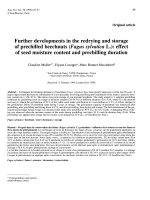
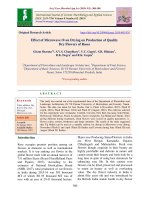



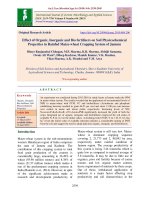
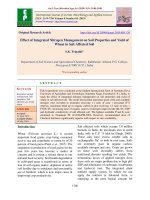
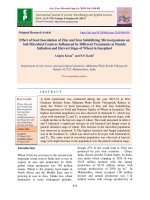
![Effect of fertility levels and stress mitigating chemicals on nutrient uptake, yield and quality of mungbean [Vigna radiata (L.) Wilczek] under loamy sand soil of Rajasthan](https://media.store123doc.com/images/document/2020_01/09/medium_ftp1578562755.jpg)
